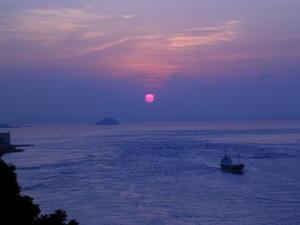Advertisement
Published: July 27th 2006

 Kitakyushu Sunrise
Kitakyushu Sunrise
Dob and I took the night bus from Hiroshima to Fukuoka, which is a city about 4 hours away. We then took the train from Fukuoka to Nagasaki. The night bus wasn't the most comfortable journey for me, but we got to see a beautiful sunrise at a pitstop about an hour outside of Fukuoka.This past weekend, I experienced my last long weekend in Japan. With still many, many places on my “Sites to See in Japan” list, and time running incredibly short, Dob and I decided to visit the city of Nagasaki for the weekend.
Nagasaki is in the south of Japan, and of course is most well-known for being the second city affected by the atomic bomb. However, much like Hiroshima, Nagasaki is a thriving, lively city today.
Our first part of sightseeing began with a visit to the Peace Park and its surrounding memorials, as well as the Peace Museum. The central focus of the Peace Park is a large statue, featuring a man with his right arm pointing to heaven in a plea of peace, and his left arm outstretched, warning of the dangers of nuclear weapons. The park also features many other statues donated from countries around the world that have partnered with the city, in a vow of peace. The museum was just as emotional and raw as the Peace Museum in Hiroshima, and again left a haunting impression of the devastating effects of nuclear weapons. Dob and I have now completed our own circuit of the

 The Peace Statue and Fountain
The Peace Statue and Fountain
The Peace Statue, neatly framed by the fountain, is one of the first sights you see as you enter the park. The right arm represents a plea for peace, and the left arm represents a warning against the threat of nuclear weapons.top 3 most depressing museums in Japan: both Peace Museums and the Earthquake Museum in Kobe.
We also visited Inasayama, to see one of the 3-most beautiful views in all of Japan (Kobe also shares this honour, along with another city that I didn’t visit). The view was indeed stunning, and we caught a glimpse of a beautiful sunset, although it was slightly cloudy. One of my favourite parts of the visit to this panorama was the Japanese-Hawaiian music group who were singing, playing ukuleles and hula dancing for their enraptured audience. It was, in a word, “sugoi!” (terrific!)
Our second day included a cruise throughout Nagasaki harbour, during which we also got to see Gunganjima, also known as “Battleship Island.” This island is the former site of a thriving coal mine community which existed up until about 1974. It had apartment buildings, schools, shrines, and even a movie theatre. Now, it’s just a mere shell of what it used to be.
We also saw Fukusaiji, which is a temple shaped like a turtle, featuring an 18 metre statue of the goddess Kannon. It was here that we got an interesting tour from a lady who I’m

 Angel of Peace
Angel of Peace
The park also featured many other statues, such as this one, donated from countries that are united with the city of Nagasaki in the quest for peace.assuming is part of the caretaking staff of the temple. She insisted on us doing certain things, such as throwing water at a specific statue, hitting a prayer bowl in order to hear it ring, and was able to unlock a secret door so we could see a Fulcrum’s pendulum, contained in the basement of the temple, which is the longest in all of Japan, and 1 of only 3 in the entire world! All of this for a mere 200 yen! (about 2 dollars…quite the deal!)
Nagasaki is known for its foreign community, as it is a port city, from which many visitors did business from all over the world. Because of this, it also has the highest Christian population in all of Japan. I was able to visit Glover Garden, which is an area that contains foreign residences. It was impressive to see an old church and houses that reminded me a lot of older, preserved Victorian-style homes in Canada.
Nagasaki shares many similarities with Hiroshima (war tragedy, the pride it has in its still running streetcars) and Kobe (large foreign community of the past, one of three best night views), but it also has a

 Remains of Urakami Cathedral
Remains of Urakami Cathedral
Because of Nagasaki's large foreign population, it also had a large Christian population as well. Urakami Cathedral was the largest church in the east, and took 3 decades to build. It was flattened in three seconds in 1945 by the atomic bomb. This section of the original cathedral is all that remains standing.feel to it, distinctly its own. I’m glad that I was able make this one of my last journeys in Japan!
Advertisement
Tot: 0.15s; Tpl: 0.012s; cc: 17; qc: 99; dbt: 0.0977s; 1; m:domysql w:travelblog (10.17.0.13); sld: 1;
; mem: 1.3mb

 Kitakyushu Sunrise
Kitakyushu Sunrise
 The Peace Statue and Fountain
The Peace Statue and Fountain
 Angel of Peace
Angel of Peace
 Remains of Urakami Cathedral
Remains of Urakami Cathedral






















